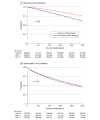Positive Airway Pressure, Mortality, and Cardiovascular Risk in Older Adults With Sleep Apnea
- PMID: 39259540
- PMCID: PMC11391331
- DOI: 10.1001/jamanetworkopen.2024.32468
Positive Airway Pressure, Mortality, and Cardiovascular Risk in Older Adults With Sleep Apnea
Abstract
Importance: Positive airway pressure (PAP) is the first-line treatment for obstructive sleep apnea (OSA), but evidence on its beneficial effect on major adverse cardiovascular events (MACE) and mortality prevention is limited.
Objective: To determine whether PAP initiation and utilization are associated with lower mortality and incidence of MACE among older adults with OSA living in the central US.
Design, setting, and participants: This retrospective clinical cohort study included Medicare beneficiaries with 2 or more distinct OSA claims identified from multistate, statewide, multiyear (2011-2020) Medicare fee-for-service claims data. Individuals were followed up until death or censoring on December 31, 2020. Analyses were performed between December 2021 and December 2023.
Exposures: Evidence of PAP initiation and utilization based on PAP claims after OSA diagnosis.
Main outcomes and measures: All-cause mortality and MACE, defined as a composite of myocardial infarction, heart failure, stroke, or coronary revascularization. Doubly robust Cox proportional hazards models with inverse probability of treatment weights were used to estimate treatment effect sizes controlling for sociodemographic and clinical factors.
Results: Among 888 835 beneficiaries with OSA included in the analyses (median [IQR] age, 73 [69-78] years; 390 598 women [43.9%]; 8115 Asian [0.9%], 47 122 Black [5.3%], and 760 324 White [85.5%] participants; median [IQR] follow-up, 3.1 [1.5-5.1] years), those with evidence of PAP initiation (290 015 [32.6%]) had significantly lower all-cause mortality (hazard ratio [HR], 0.53; 95% CI, 0.52-0.54) and MACE incidence risk (HR, 0.90; 95% CI, 0.89-0.91). Higher quartiles (Q) of annual PAP claims were progressively associated with lower mortality (Q2 HR, 0.84; 95% CI, 0.81-0.87; Q3 HR, 0.76; 95% CI, 0.74-0.79; Q4 HR, 0.74; 95% CI, 0.72-0.77) and MACE incidence risk (Q2 HR, 0.92; 95% CI, 0.89-0.95; Q3 HR, 0.89; 95% CI, 0.86-0.91; Q4 HR, 0.87; 95% CI, 0.85-0.90).
Conclusions and relevance: In this cohort study of Medicare beneficiaries with OSA, PAP utilization was associated with lower all-cause mortality and MACE incidence. Results might inform trials assessing the importance of OSA therapy toward minimizing cardiovascular risk and mortality in older adults.
Conflict of interest statement
Figures


References
Publication types
MeSH terms
LinkOut - more resources
Full Text Sources
Medical
Research Materials

